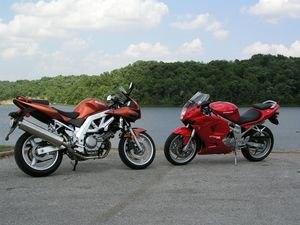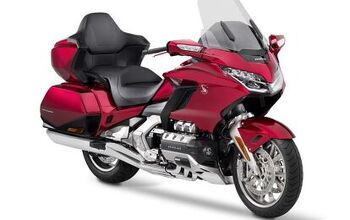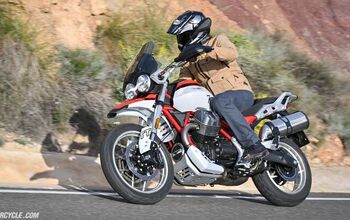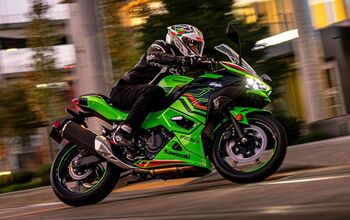
Are you considering the purchase of a Korean motorcycle?
Just being asked that question is significant in a motorcycle world that's been dominated by products from Japan, America and Europe for the last 50 years. But Hyosung, the giant Korean industrial combine, is finally offering a 650cc V-Twin sportbike to the US market. It's $950 less than the comparable Japanese model, the Suzuki SV650S, but how does it work? Are Korean motorcycles ready for prime time? We here at MO spent a lot of time discussing the Hyosung. Maven Ashley had read it was just a rebadged SV650, as Hyosung is rumored to manufacture engines and other components for Suzuki test I maintained it was just the motor that was similar. We tried to get a test unit from the
distributor, but no luck.
Suddenly, we got an email from Curtis Fisher, co-owner of MidAmerica PowerSports Plus (MAPSP) in Independence, Missouri. Not only did he have a brace of Hyosung GT650s in stock for us to paw over, he also had a Factory Pro dynamometer and a local friend with a stock 2003 fuel-injected SV650S for us to compare. Soon after that, MO expense account card in hand, I was on MO's private jet, (okay, a 6:00 AM Sunday morning Southwest Airlines flight) headed for Kansas City, MO.
Hyosung is an interesting company, and you might even be riding a one now. They've been building motorcycles since 1978 and have the production capacity to build 200,000 units a year. Their lineup includes dirtbikes, cruisers, standards and sportbikes, in addition to ATVs and other vehicles.
Their components are used in many other major brands, and they build motorcycles for one or more Japanese manufacturers that are exported worldwide. Is it the SV? Hyosung and Suzuki won't say. Introduced in other markets last year, the GT650R is a modern sportbike that shares no components with any other bike I've seen. It uses a steel frame and swingarm to contain a 650cc, dual-overhead-camshaft, eight-valve, liquid-cooled V-Twin engine. There is a monoshock with preload adjuster connected to the frame via a linkage in back, and a burly-looking top triple clamp and upside-down fork in front. Triple disc brakes slow the whole thing down. Factory claimed dry weight is 401 pounds, compared to the Suzuki's claimed 379.
"The Hyosung has a lot of nice touches for a bike priced at $5,999."
When I arrived at MidAmerica PowerSports Plus, the GT650R was parked right in front of the service entrance. It's a very good looking motorcycle, with styling derivative of Suzuki's GSX-Rs and SV650: the tailsection looks similar to the SV, while the stacked headlights say "GSX-R". The GT650 "R" model with the full fairing looks great, with smoother and more finished styling than the SV's. The GT650 "S" model, with a half fairing, also has a more finished and sleeker look than the Suzuki.
There is some good attention to detail, as it seems to have been assembled properly, with no unseemly gaps or poorly routed cables. There is a strap to secure the passenger seat, adjustable rearsets, and though the Bridgestone BT56 tires are an older model, they are known to be grippy and long-wearing. The front end is very good, with easy-to-adjust damping (but no preload adjuster), stiff looking, upside-down fork assemblies and beefy triple clamps. Brakes are two-piston, sliding-pin calipers in the front grabbing floating rotors, similar to the Suzuki's. The component quality of was a little poorer than I expected. The plastic is that brittle, older-style ABS, and the paint has a fair amount of orange peel. The clutch lever rattles, and the brake lever isn't adjustable.
The switchgear seems flimsy and lacks a sharp, positive feel. The warning stickers are badly translated; "DO NOT MAKE ILLEGAL MODIFICATIONS FOR THE SAFE RIDING" is my favorite example of Korenglish, although I am sure the owner's manual could amuse me for hours.
Our SV riding friend, Amy Eckhoff has arrived, so we're ready to roll. We'll head out to a local park with some nice scenic spots and cover a few twisty roads, so I switch the ignition on. The instrument panel dimly lights up with LCD instrumentation that looks like it was lifted from a 1987 Cadillac. It's very hard to read in daylight, although it does have a dimming function, the first time I've ever seen that feature on a motorcycle.
Amy Eckhoff
Thanks for helping MO, Amy, and keep on riding!
The motor fires up quickly and easily, with a raspy sound and noticeable vibration. The clutch has a smooth, easy pull, and the gearbox has short throws and shifts easily, although finding neutral from a stop in first gear is difficult. Pulling up to a stop, I notice that the brakes have a wooden feel and require a strong pull. Once I'm stopped, getting my feet down flat is easy, thanks to a seat that is noticeably lower than the SV's.
We get on the highway for 10 miles to ride to a local park where we can get some photos and a riding impression. The GT has a long reach to the bars, which puts an ache in your lower back after 20 minutes, but the seat is soft and supportive.
The adjustable footpegs are in a nice position, and the seat height is just right for me. The motor is buzzy above 6,000 rpm, but it is geared fairly tall and cruising at 80 (indicated- I think there's an 8-12% speedometer error) is fairly comfortable.
"Once on a curving road, the GT is very good."
There's plenty of torque for passing if you click down a gear or two, but the buzzing at high rpms is hard to take: your fingers practically vibrate right off the grips! It pulls hard in the midrange, but it isn't as sharp and satisfying as the SV's motor, which feels refined and silky smooth by comparison.
With the steel frame and swingarm, it feels noticeably heavier than the SV, but it turns in nicely and holds its line well. Steering is very linear and progressive; that's a hallmark of those BT56's! The front suspension is pretty good, tracking over bumps and not mushy at all, but the rear shock is cheap-feeling and under damped. I think the handling and ground clearance are good enough that the GT would make a decent track bike and Hyosung should consider sponsoring a spec racing class.
"The entire machine has a refined, finished feel that the Korean bike just can't duplicate. However, the Hyosung feels more composed over bumps and is just a bit more sporty, overall."
Swapping to the SV, I remember why I loved mine so much and why it's such a popular choice for beginning and advanced riders alike. It has a refined, sophisticated and friendly feel that is un-intimidating and fun at the same time. The motor is much smoother than the Hyosung's, and the entire machine has a refined, finished feel that the Korean bike just can't duplicate. However, the Hyosung feels more composed over bumps and is just a bit more sporty, overall.
Amy agreed with me about how the Hyosung compared to her SV. "It felt totally different from my SV. It felt about 20 pounds heavier, but it also felt easy to ride. It was balanced, and not top-heavy." Amy liked the way her SV "flicks" around corners, where the Hyosung needs more effort to turn; but once it is turned, it "held its line well." She guessed the Hyosung had a longer wheelbase, and she was correct: 1435mm versus 1430mm for the SV. "I doubt that a 5mm wheelbase increase would be noticeable," comments Sean Alexander, " compared to the numerous differences in geometry and tires between the two bikes. I'd look at the amount of trail and tire profile first as indicators of 'quick' steering." Hyosung doesn't list trail in the specs, howerver. Amy definitely didn't like the lower bars, but she also noted the GT650R felt bigger, too. "I didn't like the wider midsection, and if you had too much gut, you'd have a hard time with the gas tank." Still, Amy was impressed with the Hyosung's overall feel and performance.
Why Our Dyno Reads Differently Than MO's
By: Curtis Fisher
Why does MidAmerica PowerSports Plus'(MAPSP) FactoryPro EC997 Eddy Current dyno produce different horsepower numbers than Motorcycle.Com's DynoJet Model 250, you ask? Because MO's DynoJet and MAPSP's FactoryPro both correct for atmospheric deviations and parasitic losses (PL), but they go about it in different ways. Since DynoJet dynos have a larger correction factor for the inertial and frictional losses of a bike's drive train, the numbers are different. Simply put, the DynoJet software attempts to add those losses back into the horsepower and torque calculated at the rear wheel. Because they use a larger correction factor, DynoJet's final output numbers tend to be higher than those produced by a FactoryPro. The standard method of comparing a FactoryPro EC997 HP (FP HP) values to DynoJet HP (DJ HP) is relatively simple and accurate enough for an average set of readings:
100 HP Range: DJ HP = FP HP * 1.15
140 HP Range: DJ HP = FP HP * 1.20
200 HP Range: DJ HP = FP HP * 1.30
So why did MAPSP buy the FactoryPro? We do own a DynoJet model that we use for local outdoor events. However, when we selected our new dyno, we had a laundry list of criteria that the DynoJet did not meet: DynoJets are great for quick measurements of output and for comparing one motorcycle to the next, but the FactoryPro allows measurement of low-horsepower engines -- 2.5 bhp Kymco Scooters, 50cc bikes, etc -- and the DynoJet's inertia wheel is too heavy for that type of thing. In addition, the FactoryPro eddy current dyno can hold an engine at any rpm the operator chooses -- a so-called "steady state" dyno -- so it is capable of making more accurate fuel injection maps and is generally better for fine tuning. An example: Accurate fuel injection is critical at all throttle positions at all rpms, and this is hard to do with an inertia-only dyno. Another item that was important to us for tuning purposes is the fact that the FactoryPro is capable of monitoring all the gases produced (O2, CO, HC, CO2,) where the DynoJet just relies on an O2 sensor in the exhaust.
So which number is best? Both, neither, and any combination of the two depending on how you want to interpret horsepower (which is a calculated number to begin with) and where you chose to measure it -- crankshaft, rear sprocket like some eddy current dynos do, or rear wheel, and whether you want to correct for those parasitic losses.
I prefer the FactoryPro because I think it more accurately represents the true horsepower output by a machine. Many other people -- Motorcycle.Com included -- don't seem to care as long as the measuring device is accurate and the relative differences between all bikes can be fairly gauged. At the end of the day, I maintain, it's all moot: whichever bike has the right combination of variables to get you down the 'strip or around a racetrack the fastest is the best.
--Curtis
"It turns so nicely and holds its line so well that I'm disappointed the exit comes up so quickly."
The next morning, I got up early to take the GT on a blast down Blue River Road, a short but fun piece of pavement to the south, with a few nice turns and even less traffic.
I was able to stretch the bike's legs a bit, so I grew to like this raw and simple roadburner. The throttle response is not as crisp or responsive as that delivered by the SV's more sophisticated fuel injection, but the bike still lunges forward at 6,000 rpm and easily gets into triple-digits on the speedometer without much effort. It turns so nicely and holds its line so well that I'm disappointed the exit comes up so quickly, since I'm having so much fun darting in and out of what passes for heavy traffic in suburban Kansas City.
Once on the stretch of smooth pavement, freshly washed by an early morning rainstorm that also brought temperatures down to tolerable levels, I get more confidence in the GT's chassis, brakes and tires. With 58HP on a FactoryPro dyno compared to the SV's 60 on that same dyno (this translates to 65.5 and 68 on a Dynojet), the motor is more than adequate to have a good time, and I'm again impressed by the stout front suspension. The rear shock is pretty cheap, but luckily the bike is light enough to not tax it too much. How good a value is the GT650? With the full fairing, the GT650R is priced at $5,999, $5,499 for the half fairing GT650S. The SV650S with half fairing is $6,449: $950 more!
That will buy you an exhaust system, jetting and whatever other add-ons you could want. But the SV does give you a smoother motor, better throttle response and the luxury of fuel injection. Plus, the build quality is superior. Another consideration could be resale value and warranty service, a pitfall for new brands. A better comparison would be to Suzuki's venerable GS500F, which is priced at $5,199 with a full fairing. But that bike has an anemic, ancient air-cooled motor that barely puts out 40 HP, squishy suspension, a single disc brake and skinny, bias-ply tires.

Motorcycle.com presents an unrivaled combination of bike reviews and news written by industry experts
More by Motorcycle.com Staff







































Comments
Join the conversation